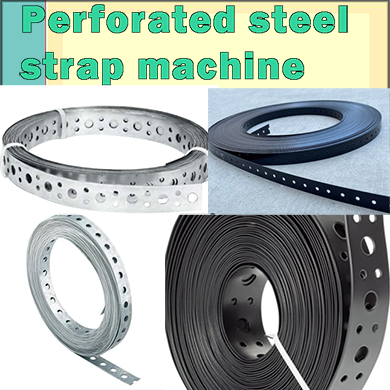video of the machine for making perforated steel straps
Material: Typically made from low-carbon (mild) steel for good strength and formability. It can also be found in:
Galvanized Steel: Coated with zinc for excellent corrosion resistance (most common for outdoor/industrial use).
Stainless Steel (e.g., 304 or 316): For high corrosion resistance in harsh environments (food processing, chemical plants, marine applications).
Pre-painted or Coated Steel: For specific aesthetic or minor protective needs.
Dimensions:
Width: Ranges from about 1/4" (6mm) to 2" (50mm) or more.
Thickness (Gauge): Usually between 0.028" (22 gauge) and 0.075" (14 gauge). Thicker gauges are stronger but less flexible.
Length: Sold in coils or cut-to-length pieces, commonly from 25 ft to 100 ft rolls.
Perforation Pattern:
The holes are usually round or slotted.
Round Holes: Most common, used with screws, bolts, or zip ties.
Slotted Holes: Allow for adjustment along the length of the strap, which is ideal for mounting where precise alignment is difficult.

This product is a workhorse in many industries due to its simplicity and strength.
Electrical Conduit and Cable Tray Support:
This is one of its most common uses. The strap is used to securely fasten electrical conduits (metal pipes containing wires) and cable trays to walls, ceilings, or beams. A screw goes through a perforation into the structure.
HVAC (Heating, Ventilation, & Air Conditioning):
Used for hanging ductwork, insulating pipes, and securing various components. Its flexibility allows it to be formed around irregular shapes.
Plumbing:
Ideal for strapping water pipes, gas lines, and drainage pipes to joists and studs to keep them secure and prevent movement.
Construction and General Mounting:
A general-purpose fastener for hanging signs, securing fencing, creating custom brackets, or bundling items together.
Industrial Packaging and Bundling:
Used to bundle long, bulky items like lumber, metal bars, or tubes for shipping and storage. It's much stronger than plastic strapping.
Strength and Durability: Provides a strong, non-stretching, and long-lasting hold.
Adjustability: The perforations allow for attachment points anywhere along its length, offering great flexibility during installation.
Easy to Work With: Can be cut with tin snips or a hacksaw and bent by hand. No special tools are required for basic applications.
Cost-Effective: An inexpensive solution for a wide range of fastening and support problems.
Fire Resistance: Unlike plastic ties or straps, steel is non-combustible, which is critical in electrical and building safety codes.
Measure and Cut: Determine the length needed and cut the strap with appropriate cutters.
Position: Wrap or place the strap around the object you are securing (e.g., a pipe).
Fasten: Bring the ends to the mounting surface (e.g., a wooden stud).
Secure: Insert a screw, bolt, or nail through a perforation and drive it into the mounting surface. For bundling, you can often screw the two ends of the strap together
| Feature | Perforated Steel Strap | Plastic Zip Ties | Solid Steel Strap |
|---|---|---|---|
| Strength | High | Low to Medium | Very High |
| Adjustability | Excellent (holes along length) | Good (locking head) | Poor (requires a special buckle) |
| Corrosion Resistance | Good (if galvanized or stainless) | Good | Good (if coated) |
| Ease of Installation | Easy (basic tools) | Very Easy | Difficult (requires tensioning tool) |
| Cost | Low | Very Low | Medium to High |
| Primary Use | Mounting, supporting, bundling | Light-duty bundling | Heavy-duty palletiz |